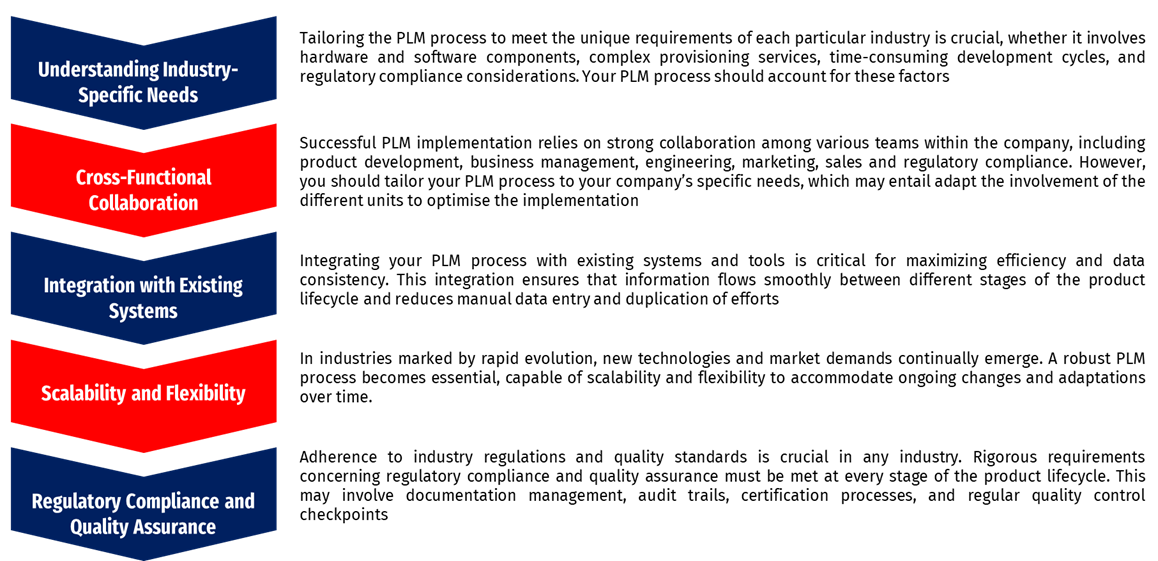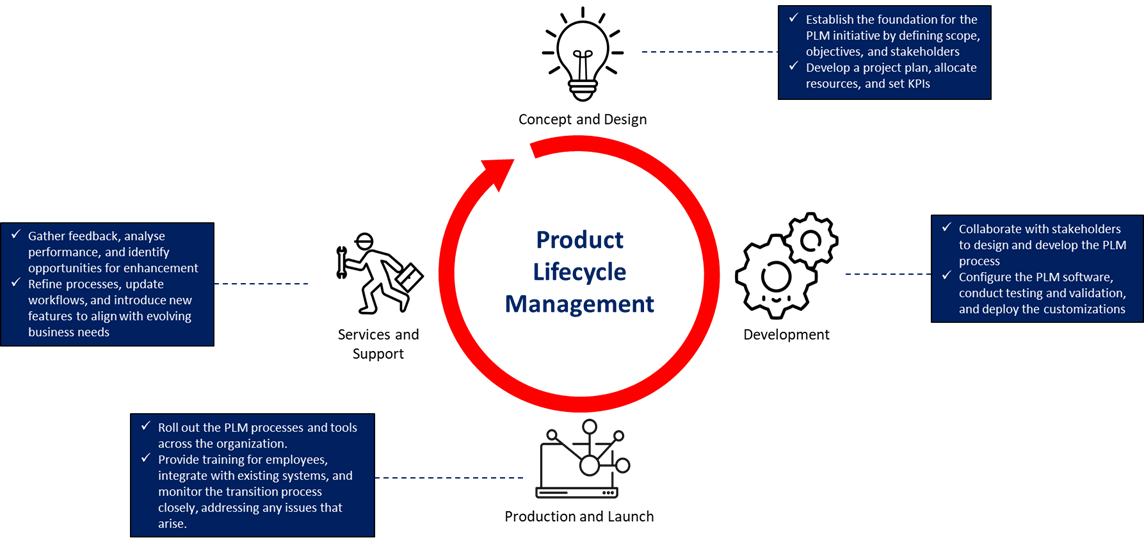Table of Contents
Picture this: with a proper Product Lifecycle Management (PLM) process in place, every team member knows exactly where they stand, what their role involves, and how their efforts contribute to the overall success of the product development process.
Implementing a strong lifecycle strategy is crucial for businesses aiming to stay competitive. Understanding how to manage product life cycle effectively allows companies to optimize resources and enhance efficiency.
By embracing strategic lifecycle management, organizations can ensure smoother transitions between different stages of the product while reducing inefficiencies and maximizing profitability.
01
of 06
What is Product Lifecycle Management?
At its core, Product Lifecycle Management (PLM) is a holistic approach to managing a product’s entire lifecycle, from its conception through development, launch, and eventually retirement. It involves PLM processes, cross-functional teams, and strategic planning to optimize every stage of the product journey.
Think of it as a centralized hub where all product-related information is stored and managed. With PLM solutions, companies gain complete visibility into the product lifecycle, enabling improved collaboration, better decision-making, and, ultimately, greater success.
This indicates a significant demand for PLM solutions across various industries, including telecommunications.
The demand for PLM software is anticipated to grow in the coming years due to the increasing need for software solutions that support change management, data management, and governance management.
By embracing a PLM strategy, you’re not just streamlining PLM processes; you’re fostering a culture of collaboration and efficiency. Cross-functional teams can work seamlessly together with clearly defined stages and checkpoints, eliminating chaos and delays often associated with product development processes. Think of it as having everyone on the same page, working towards a common goal with coordinated efforts.
With clearly defined stages and checkpoints, teams can work seamlessly together, eliminating the chaos and delays often associated with product development. Think of it as having everyone on the same page, working towards a common goal with coordinated efforts.
From enhancing product quality based on continuous cooperation to making data-driven decisions that boost profitability, PLM empowers companies to stay agile and competitive in a rapidly evolving market. It’s not just a tool; it’s a strategic investment in your business’s future success!
02
of 06
How does PLM impact your industry?
Implementing a PLM process in your company holds great potential for optimising your product development, launch and management procedures.
Here’s what should be considered and expected when defining and adopting this process:

By addressing these considerations, you can optimise your PLM practices and drive greater success in the competitive market in which you operate.
03
of 06
The lifecycle journey: Phases of implementing PLM
The implementations of this process typically include several distinct phases, each serving a specific purpose in managing the lifecycle of products within your company.
Let us guide you through the lifecycle journey of implementing a PLM process:

04
of 06
Benefits of implementing PLM on top of your Salesforce
Companies using Salesforce have reported significant improvements in customer satisfaction and loyalty. For example, T-Mobile achieved a 70% reduction in work effort after implementing Salesforce, increasing customer satisfaction and reducing service costs.
Implementing this strategy in your Salesforce organization brings several significant advantages:
- Simplified Data Management: Salesforce acts as the organized librarian for your company’s product journey, employing the federated catalogue approach. It gathers all your product-related information – like specs – into one tidy digital library. With seamless integrations with specific systems and platforms, Salesforce ensures that your product data stays in sync across all systems. It’s like having a unified command centre for your operations, simplifying processes and empowering your team to work more efficiently.
- Efficiency Boost with Automation: Think of Salesforce as your productivity partner, streamlining your PLM processes with smart automation. It takes care of the repetitive tasks – like approvals and notifications – so your team can focus on the creative work. With Salesforce’s automation features, you can set up workflows that guide tasks seamlessly from start to finish, ensuring nothing falls through the cracks. Salesforce traceability capabilities will also allow for tracking activities, registering a complete audit trail of any action or change.
- Empowered Customer Connections: Salesforce transforms your PLM processes into supercharged experiences, helping you understand your customers’ needs and preferences from ideation to retirement. Integrating PLM processes with CRM systems as Salesforce can lead to a more holistic view of the customer journey, resulting in a 360-degree customer view and improved cross-functional collaboration. This integration can drive revenue growth and operational efficiency for the company.
- Enhancing Product Quality and Customer Experience: One of the primary advantages of PLM is that it improves product quality by enabling continuous cooperation among cross-functional teams. When customer feedback is integrated into the product lifecycle, companies can continuously improve their products or services, ensuring a better customer experience. This not only strengthens customer relationships but also builds brand loyalty over time.
- Reducing Costs and Time to Market: Another significant benefit of PLM solutions is their ability to reduce costs and reduce time to market. By streamlining PLM processes, project managers can identify inefficiencies early in the product development process, preventing costly mistakes. Moreover, cross-functional teams can work in unison, ensuring a seamless workflow from concept to launch.
- Aligning Business Goals with Marketing Strategies: A well-implemented PLM strategy ensures that product development aligns with broader business goals. Through robust marketing strategies, companies can position their products or services more effectively, maximizing their impact in the market. The ability to make data-driven decisions based on real-time insights allows businesses to stay ahead of trends and competitors.
05
of 06
Tips for successful PLM implementation
Implementing this process can be a significant undertaking, but with careful planning and execution, you can ensure a smooth transition for your team.
Here are some tips for a successful implementation:

06
of 06
We can enhance and streamline your Product Lifecycle Management process
As a seasoned Salesforce consulting boutique, our 16 years of experience speak volumes about our commitment to delivering exceptional results.
Our success in implementing PLM solutions across different industries solidifies our expertise and deep understanding of the unique challenges individual customers face in this industry, giving them product lifecycle management best practices. Leveraging our TETRIS values—teamwork, expertise, trust, responsibility, innovation, and satisfaction—we approach every project with a relentless focus on driving value and exceeding client expectations.
Our collaborative approach ensures that every team member contributes with expertise to deliver results exceeding client expectations. We prioritize transparency, integrity, and commitment to ensure our clients’ trust and satisfaction throughout every project. By leveraging the latest technologies and methodologies, we empower companies to drive tangible business outcomes and stay ahead of the curve in the ever-evolving markets.
Partnering with a seasoned Salesforce consulting company as Stellaxius unveils a thrilling adventure. Together, we navigate the twists and turns of the industry landscape with confidence and flair. With a dash of creativity, a sprinkle of expertise, and a pinch of innovation, we turn challenges into certain victories.






